Physical Address
304 North Cardinal St.
Dorchester Center, MA 02124
Physical Address
304 North Cardinal St.
Dorchester Center, MA 02124
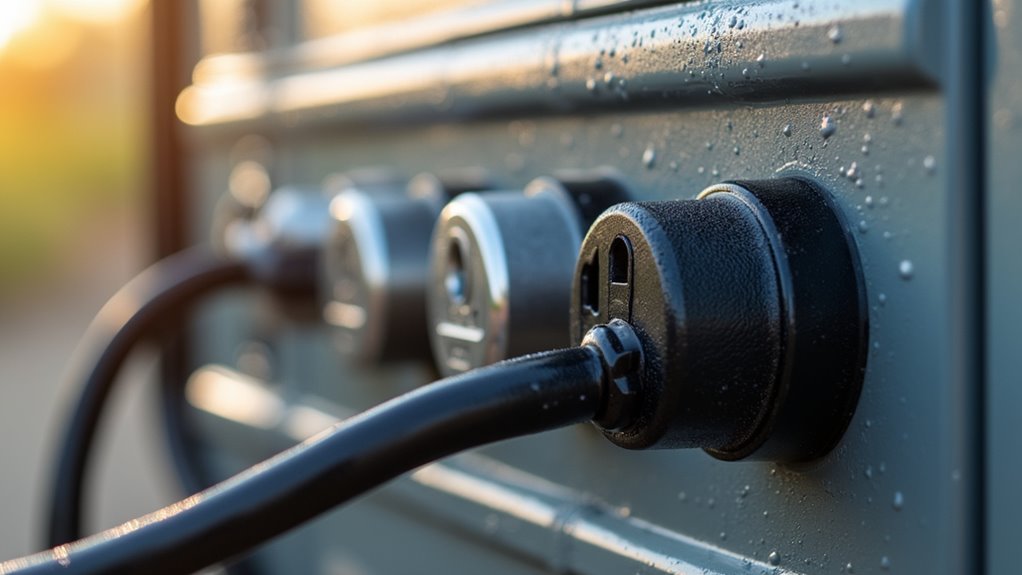
Learn how RV electrical systems combine shore power, batteries, and generators to keep your camping adventures powered up safely.
You’ll find that your RV’s electrical system is both simpler and more complex than your home setup. While you’re camping, you’ll rely on a combination of AC shore power, DC battery power, and possibly generator backup to keep your comforts running smoothly. Understanding the basics of RV electrical systems isn’t just about convenience—it’s about safety and avoiding costly mistakes. Let’s explore how these different power sources work together to create your home away from home.
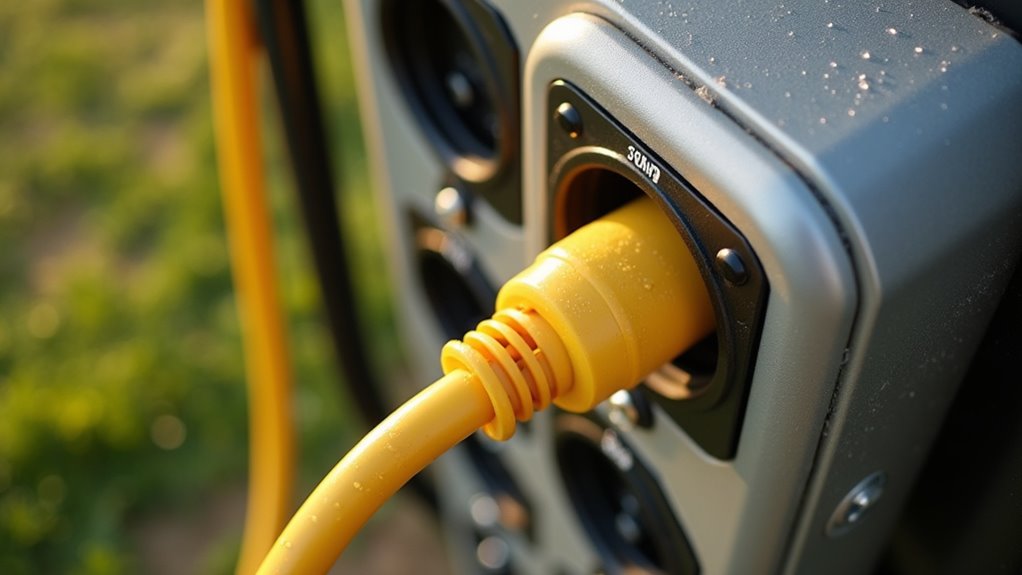
When setting up your RV for shore power, you’ll need to understand the basics of connecting to external electrical sources. Most RVs use either 30-amp or 50-amp service, with smaller campers typically running on 30-amp and larger motorhomes requiring 50-amp connections.
RV shore power comes in 30-amp or 50-amp configurations, with smaller units using 30-amp and larger motorhomes needing 50-amp service.
You’ll find that shore power lets you run your air conditioning, heating, and other appliances without draining your batteries or running a generator. It’s essential to match your RV’s power inlet to the campground’s pedestal – using the wrong amperage can damage your system. A surge protector device is crucial for safeguarding your RV’s electrical system from power fluctuations.
While some locations offer 15-amp or 20-amp service, these aren’t as common for RVs. Don’t forget to carry adapters for different outlet types, as campground setups vary.
Always inspect your cables and connections before use to guarantee safe operation.
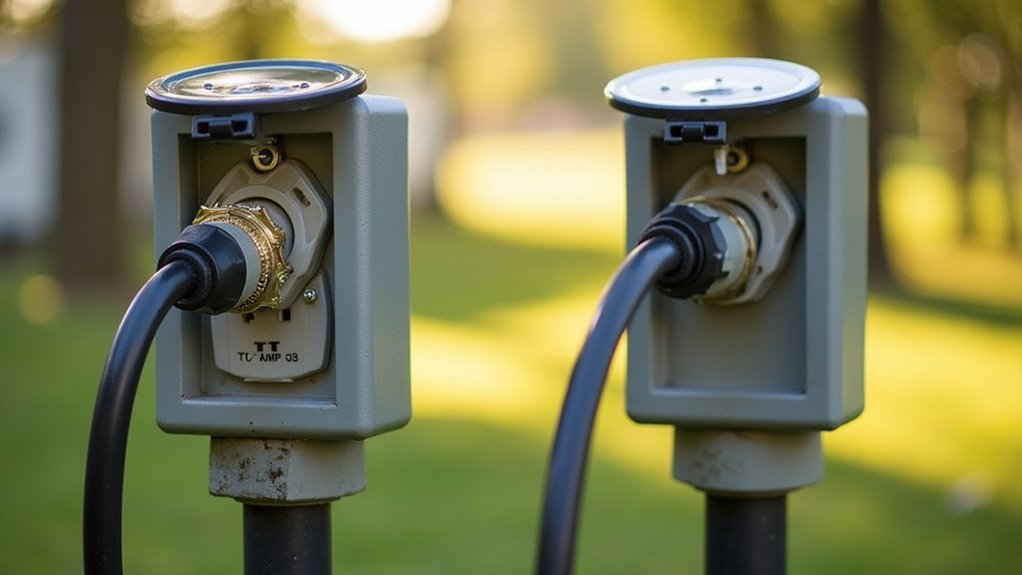
Understanding the key differences between 30-amp and 50-amp RV electrical service will help you choose the right setup for your needs. The most significant distinction is power capacity: 30-amp systems provide up to 3,600 watts, while 50-amp systems deliver up to 12,000 watts.
You’ll notice physical differences in the plugs too. A 30-amp system uses a three-prong plug with one hot wire, while a 50-amp system has a four-prong plug with two hot wires. When using high-draw appliances like air conditioners and microwaves, you’ll need to monitor your total amp usage carefully.
If you’ve got a smaller RV, you’ll likely do fine with 30-amp service, but larger RVs need 50-amp to support multiple appliances. While you can use adapters to connect a 50-amp RV to a 30-amp outlet, you’ll need to manage your power usage carefully.
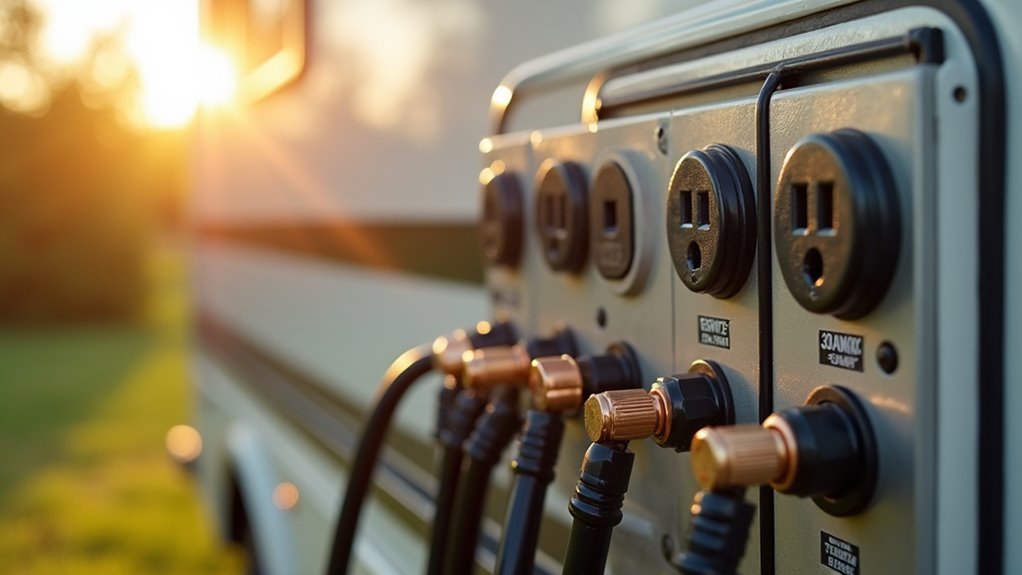
Your RV’s electrical system relies on several key components working together to keep your mobile lifestyle powered and comfortable. The core elements include your shore power cord for campground hookups, a generator for off-grid power, and a DC battery bank for essential 12-volt systems.
A converter transforms 120V AC to 12V DC to charge your batteries, while an inverter does the opposite, letting you run household appliances from battery power. Solar panels can provide a sustainable power source for extended off-grid camping adventures.
You’ll find safety features like circuit breakers, GFCIs, and surge protectors safeguarding your system from electrical issues. Distribution panels manage power flow throughout your rig, and monitoring devices help you track voltage and current usage.
Various isolation components guarantee your AC and DC systems operate independently while maintaining necessary integration points for seamless operation.
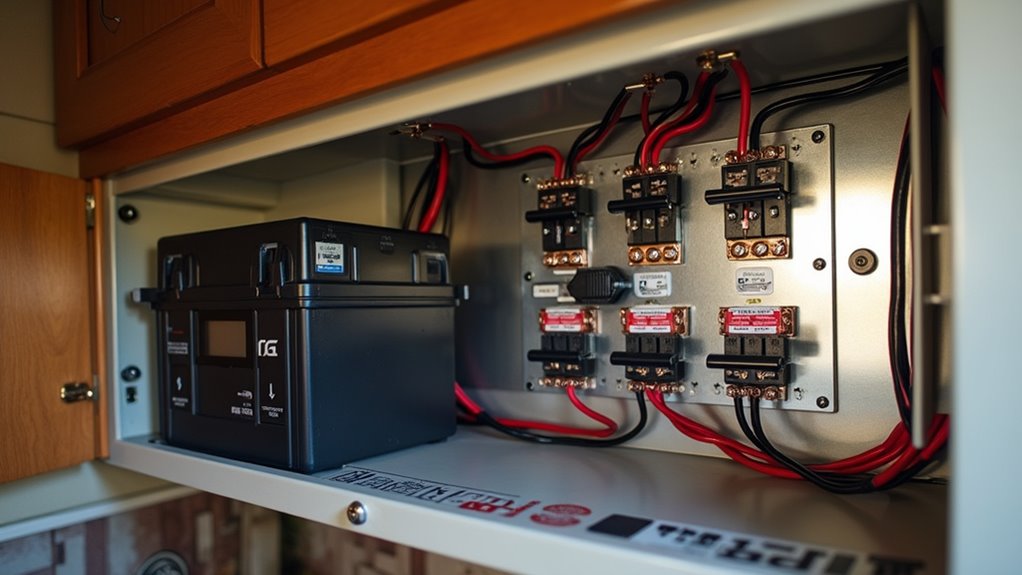
The 12V DC system serves as the backbone of your RV’s electrical infrastructure, powered primarily by deep-cycle batteries that run essential components like lights, fans, water pumps, and safety devices.
Deep-cycle batteries power your RV’s essential 12V system, keeping vital components running from lights to safety equipment.
You’ll typically find lead-acid batteries in most RVs, though lithium options are becoming popular for their longer lifespan and better performance. Your batteries get charged through multiple sources: shore power via a converter, solar panels, your engine’s alternator while driving, or a generator when boondocking. Using a Blue Sea fuse block provides crucial protection for your electrical circuits.
To distribute power effectively, your RV uses a fuse panel that protects individual circuits from overcurrent. You’ll need to monitor your battery levels regularly and maintain clean terminals to guarantee reliable operation.
For extended off-grid stays, you can expand your setup with additional batteries wired in parallel to increase capacity without changing voltage.
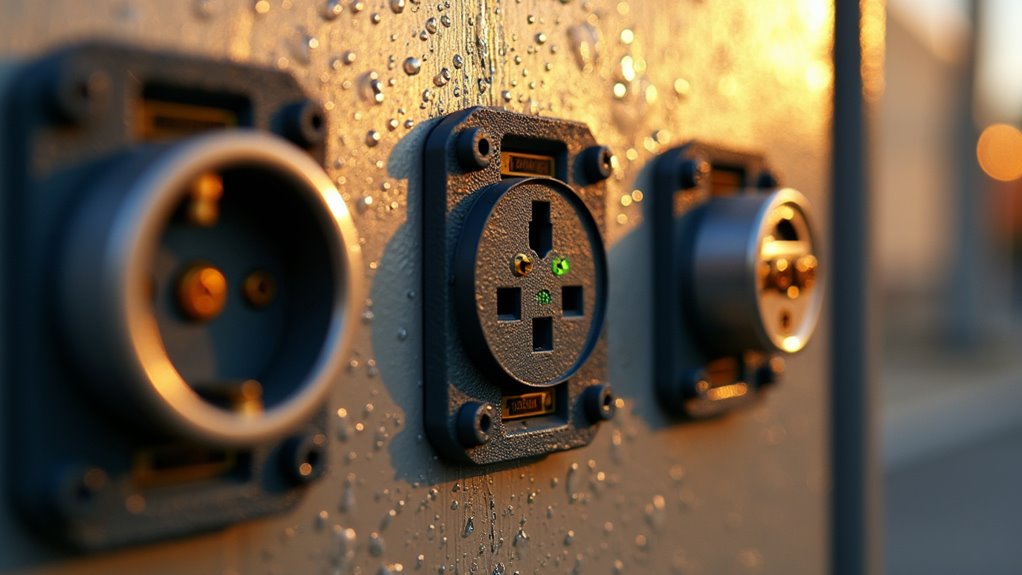
Properly managing your RV’s power load and protecting its circuits will help prevent electrical issues that could ruin your trip. Start by calculating your total power consumption and distribute loads across multiple circuits to avoid overloading. Use power monitoring devices to track usage and stay within safe limits.
Install essential protection devices like circuit breakers and GFCIs to guard against electrical hazards. Modern EMS units like the EMS-HW50C provide open ground protection to safeguard your RV’s electrical system. You’ll also need surge protectors rated appropriately for your RV to shield against voltage spikes. Consider investing in an Electrical Management System (EMS) that provides all-encompassing protection and monitoring capabilities.
Don’t forget to regularly inspect your electrical components and maintain them according to safety standards. Keep an eye on fault indication systems and establish clear procedures for handling electrical emergencies.
This proactive approach will guarantee your RV’s electrical system remains reliable and safe.

Safe connection practices begin long before plugging your RV into a campground’s power source.
Proper electrical safety starts well before your RV arrives at the campsite – it begins with preparation and knowledge.
You’ll need to locate the pedestal breaker and verify it’s switched off before handling any connections. Always inspect your power cord, adapter, and the campground outlet for signs of damage or wear. Using heavy-duty outdoor cords designed specifically for RV use is essential for safe power connection.
When you’re ready to connect, start by plugging your surge protector into the pedestal first.
Then connect your RV power cord to the surge protector. Make sure all connections are secure and won’t come loose. Only after everything’s properly connected should you turn the breaker back on.
Don’t forget to avoid handling electrical connections in wet conditions, and keep your power cords away from high-traffic areas.
If you notice any issues with the pedestal wiring, notify campground staff immediately.
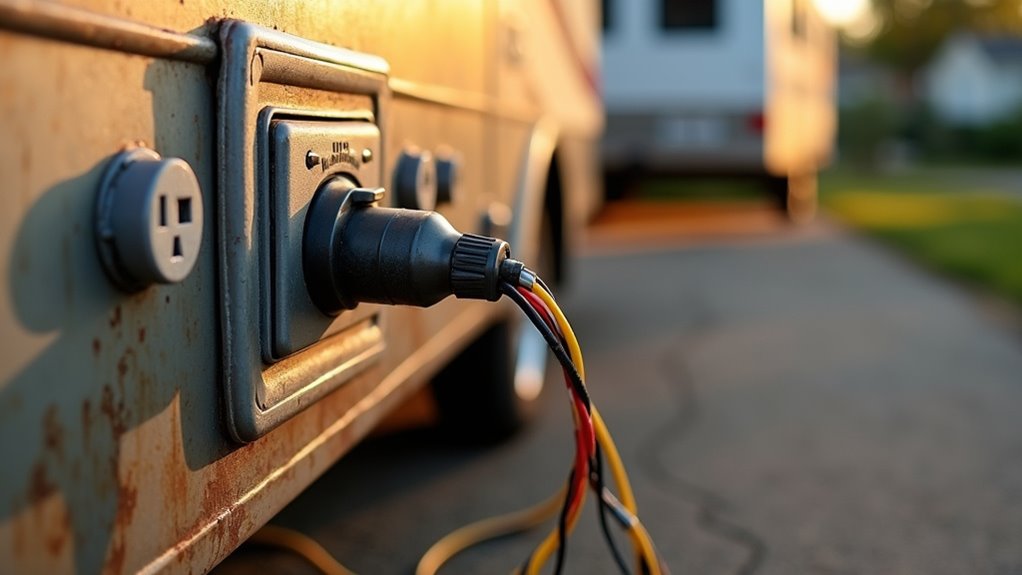
Selecting the right generator for your RV involves understanding three key power options: gasoline, diesel, and propane units. Each type offers distinct advantages, with diesel providing superior fuel efficiency and longevity, gasoline offering affordability and availability, and propane delivering cleaner operation with reduced emissions. Modern portable power stations provide an eco-friendly alternative to traditional fuel-based generators.
When setting up your generator, guarantee proper ventilation and maintain safe distances from your RV.
You’ll want easy access for maintenance while keeping noise levels manageable for both you and your camping neighbors.
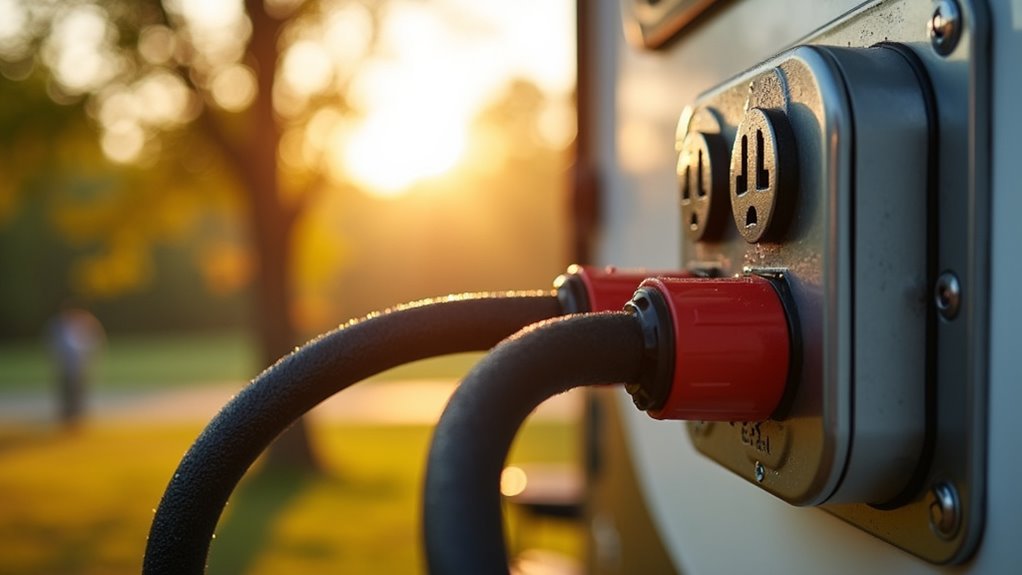
While having the right generator setup helps power your RV, electrical issues can still pop up during your travels.
Even with proper generator equipment, RV travelers should stay prepared for unexpected electrical challenges on the road.
You’ll likely encounter common problems like system overloads from running too many appliances at once, or weak batteries that won’t hold a charge. Watch for signs like frequently tripped breakers, flickering lights, or power loss.
Your power converter might fail to properly charge batteries from shore power, while loose or corroded wiring can cause intermittent electrical issues. Rodent damage to exposed wires can also create electrical problems in RVs.
If you’re experiencing repeated breaker trips or blown fuses, don’t just reset them – investigate the underlying cause.
Keep your electrical system healthy by regularly inspecting battery terminals, maintaining proper wire connections, and avoiding circuit overloads.
When problems persist, consult a professional to prevent damage to your RV’s electrical components.
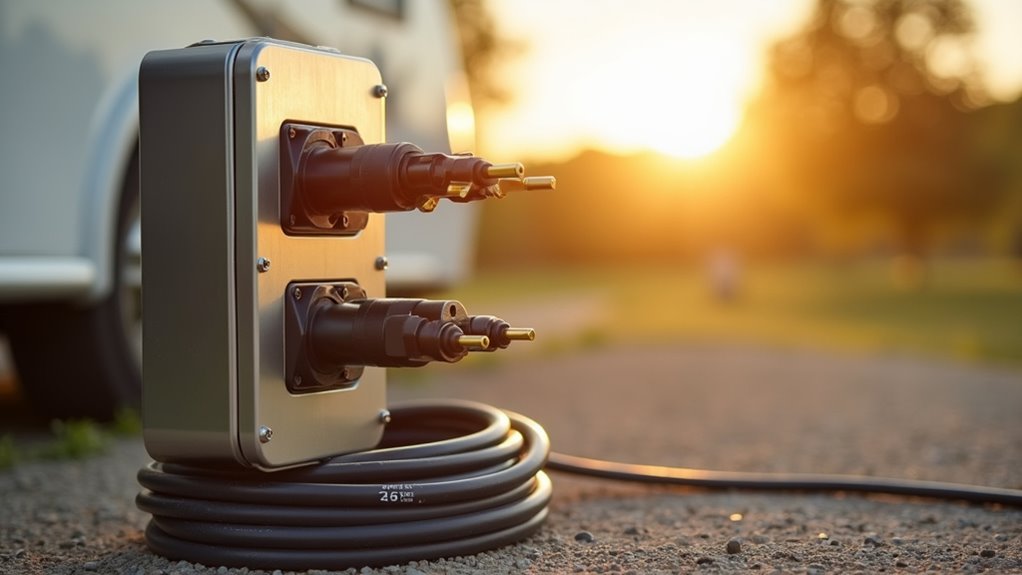
Effective power management in your RV starts with understanding how to balance your electrical needs across different power sources.
You’ll need to monitor your power consumption carefully and use the right source for each appliance. Run your air conditioning and microwave on shore power or generator, while using battery power for lights and fans. RVs typically utilize 30-amp or 50-amp shore power connections that determine how many appliances can run simultaneously.
Always test power pedestals before connecting, and use surge protectors to safeguard your RV’s electrical system.
Knowledge is power, and that’s especially true with your RV’s electrical system. You’ll save time, money, and headaches by understanding your power needs, from shore connections to battery management. Whether you’re running a 30-amp or 50-amp setup, always prioritize safety and proper load distribution. Keep your adapters handy, maintain your components, and you’ll be ready to plug in and power up wherever your adventures take you.